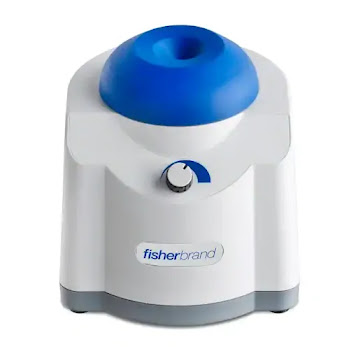Vortex Mixer - Definition, Principle, Parts, Procedure, Types, Applications
A vortex mixer is a simple device used commonly in laboratories to mix small vials of liquid. It consists of an electric motor with the drive shaft oriented vertically and attached to a cupped rubber piece mounted slightly off-center. As the motor runs the rubber piece oscillates rapidly in a circular motion. When a test tube or other appropriate container is pressed into the rubber cup (or touched to its edge) the motion is transmitted to the liquid inside and a vortex is created. Most vortex mixers are designed with 2 or 4-plate formats, have variable speed settings ranging from 100 to 3,200 rpm, and can be set to run continuously, or to run only when downward pressure is applied to the rubber piece.
Brothers Jack A. and Harold D. Kraft developed the vortex
mixer while working at Kraft Apparatus, Inc. in Mount Vernon, New York (a
laboratory apparatus manufacturer). They precisely stir samples to promote
reactions or homogenization using a rather simple process. Samples are
simultaneously shaken and vortexed at high speed, which is intended to combine
difficult samples like compact pellets and tiny or viscous samples and can be
used with tubes from 0.2 to 50 ml.
This apparatus is compact, quiet, and equipped with several
inserts that enable the agitation and mixing of samples of various sizes.
Rapidly oscillating motorized drive shafts under the sample platform transmit
orbital motion to sample containers positioned inside the mixer. This results
in the turbulent flow- also referred to as a vortex of the sample fluids. This
is the kinetic force that is comparable to stirring but does not involve a
component that protrudes into the sample container. Microplates may also be
affixed.
This is preferred for numerous applications in microbiology
and the biological sciences that need sensitive samples or high throughput
processes. A standard stirrer can only mix one sample container at a time. It
cannot combine fluids in sealed flasks, and it is sometimes necessary to
combine the reagents for biochemical experiments. In contrast, vortex mixers
are typically designed with a minimum dual-plate structure, allowing for the
simultaneous mixing of numerous samples. While their primary function is mixing
samples and chemicals, vortex mixers can also be used to suspend cells.
Working Principle of Vortex Mixer
The drive shaft of the motor for vortex mixers is positioned
vertically, and a cupped rubber piece is mounted somewhat off-center. The
rubber component will quickly oscillate in a circular motion when the motor is
running. A vortex will form in the sample when it is placed on the rubber piece
because the motion is transferred to the liquid. This enables ferocious sample
mixing.
Parts of Vortex Mixer
- Main switch: The electrical current necessary to run the vortex mixer is supplied by turning on the main switch. It manages the machine’s power.
- Motor: It is the core of the vortex mixer and rotates in a circular motion. It is located immediately below the cup head. For proper sample homogenization, it creates a vortex effect in the liquid.
- Speed controller knob: The speed control knob is located in the front panel of the machine. The speed of the rotation can be adjusted by turning the knob.
- Operation controller button: An embedded control unit offers the ability to program the mixer’s operation.
- Cup head: Cup heads are available in various sizes and allow rapid mixing. To blend a range of tube sizes, these heads are simply interchangeable with various-sized cup heads. The tube is positioned on the cup head to produce a vortex.
Digital/Pulsing Vortex Mixer also comprises all the switches
and controls with the addition of a display and pulsing facility.
- Time display: shows the length of time that has passed (in continuous mode) or the remaining time (timed mode).
- Speed display: shows how fast the vortex mixer is moving.
Accessories
Tube platforms
- The mixer for which they are designed has a specialized tube holder. These platforms can accommodate a range of tubes of various sizes, hence expanding the number of samples that can be vortexed simultaneously.
Single tube holder
- To hold the tube into the cup head for prolonged mixing, a tube holder that attaches to the top of the vortex mixer is needed. This makes it possible for the sample to be mixed independently.
Tube insert
- A tube insert can handle tubes of various sizes.
Vortex mixer operating procedure
The front panel of the device houses all of the functioning controls. Three positions- TOUCH, OFF, and ON are available on the power switch, which is situated on the left side of the panel.
- TOUCH- The TOUCH position turns on the mixer by depressing the mixing head while the operation will halt when pressure is released from the mixing head.
- ON- When the switch is ON, the mixer will run constantly.
- OFF- The mixer will stop running when turned to the OFF or TOUCH position.
The knob of adjustable speed control on the right side of the panel, when turned clockwise, causes the oscillating speed to increase at a non-linear pace up to a maximum of 3,400rpm. Set the speed control to the lowest setting before starting the mixer.
The steps, including operating procedures, are:
- Place the power switch in either the TOUCH or ON position to activate the device.
- Turn the speed control to the chosen setting.
- The shaking head will start moving immediately when the power switch is turned on.
- When the power switch is set to the TOUCH setting, the device will start operating when anything is placed on the shaking head, and a small amount of pressure is used to depress it.
- As soon as the pressure is lifted and the object is removed, the shaking will stop.
- Turn the speed-controller knob to the desired speed.
- Disconnect the main switch.
Types of Vortex Mixers
Variable speed vortex mixers
It facilitates users to regulate the speed of the mixing
process. This offers flexibility because
the higher speeds can be utilized for more forceful agitation while the lower
speeds can be used for the delicate mixing of the samples.
Fixed-speed vortex mixers
When the head is depressed, fixed-speed vortex mixers begin
mixing. It rotates at full rpm to produce powerful vortexing of samples because
the speed is fixed.
Digital vortex mixers
The Digital Vortex Mixer features an accurate continuous
function or an on-demand pulsing function, as well as a digital time and speed
display. The speed ranges from 300 to 4,200 rpm, which covers a wide range from
forceful mixing to low-velocity mixing. A 250 ml capacity flask, a foam insert
plate holding a single microtiter plate, a universal platform, and a foam
insert tube holding microtubes are among the accessories.
Mini Vortex mixers
The Mini Vortex Mixers are smaller and more portable. The
suction cup at the bottom of the device increases stability while producing
hardly audible vibrations. It is made exclusively for agitating test tubes. To
begin shaking, merely the tube is inserted into the soft attachment. As soon as
the test tube is removed, the shaking ceases. It is a robust mixer with a
footprint of 100 mm by 100 mm and a top speed of 4,500 rpm.
Analog vortex mixers
It is possible to start up an analog vortex mixer at a low
rpm for gentle shaking or at a high rpm for vigorously vortexing samples. You
can choose between touch mode, which activates mixing when you press the cup
head, and continuous mode, which is for use with accessory attachments.
Pulsing vortex mixer
Excellent cell disruption for glass bead treatments is
produced by strong pulsing vortex activity. The Pulsing Vortex Mixer can
completely disrupt the cells in samples in just a few minutes. A unique
pulsating action decreases heat generation while enhancing mixing and
disruption. The system has an accessible container for micro-centrifuge tubes
measuring.5 mL or 2.0 mL.
Multi-tube Vortex mixers
Flasks and tubes can be mixed in a single or several tubes using
Multi-tube vortex mixers. They don’t quite reach the velocity speed of the more
basic mixers that carry fewer vials because their speed ranges from 300 to
2,500 rpm. The attachments include tube foam made to hold tubes and flask foam
made to hold flasks.
Microplate vortex mixer
Microplates can be mixed at any speed with the use of vortex mixers. All of the models were created with continual lab use in mind. Non-digital variable speed models are a cost-effective alternative to digital models for applications that require predictable outcomes.
Applications of Vortex Mixer
- It has wide application in the clinical and medical sectors for thawing and mixing samples.
- The vortexer has been used to suspend cell or tissue samples for use in tissue analysis and cell culture.
- When investigating proteins and enzymes, a vortex mixer is essential for the homogeneous mixing of samples with reagents and buffer.
- It is also utilized in heating and mixing samples in pharmaceutical areas.
- It is employed in schools and universities for practical demonstrations and experiments.
- Vortexer is used in quality control testing and sample preparation for industrial use.
Advantages of Vortex Mixer
- The various speed options guarantee that the intended speed is kept constant throughout the process.
- Depending on how many vials are being mixed at once, vortex mixers can hold one vial up to a dozen.
- Additionally, the vortex mixer works with minimal resources, expertise, and resources.
- The vortex mixer ensures an effective and dependable way of mixing samples.
Limitations of Vortex Mixer
- If the tube is held incorrectly, there is a chance of spilling.
- It does not apply when combining solid and liquid or solid and solid components.
Safety Precautions of Vortex Mixer
- Never use the device without a shaking head that is firmly fastened.
- Always use impact-resistant eye protection.
- Avoid mixing or using solvents and flammables near or on the mixer.
- Shake potentially dangerous samples in the proper containment vessels.
Examples of Vortex Mixer
Fisherbrand™ Mini Vortex Mixer (Manufacturer: Fisher
Scientific)
- The Fisherbrand™ Mini Vortex Mixer is a very small vortex mixer that rotates in a horizontal orbit.
- It accepts all sizes of tubes and containers.
Vortex laboratory mixer Vornado™ (Manufacturer: Benchmark
Scientific)
- It is a powerful mini vortexer that vortexes even the largest samples, such as 50 ml tubes. Thanks to its 4 mm orbit and fixed speed of 2800 rpm.
- Despite having a strong motor, the Vornado can fit on even the busiest bench thanks to its small footprint of fewer than 44 inches.
- The Vornado’s distinctive head shape keeps liquids from getting into the housing, extending the motor’s life.
Vortex mixer VMX-MT (Manufacturer: Bioevopeak)
- The VMX-MT Multi-Tube Vortexer uses brushless DC motor technology and microprocessor control.
- It can only process 50 samples at once at most.
- The mixing requirements of various test tubes can be met by choosing from a selection of test tube foams.
Vortex-Genie 2 (Manufacturer: Scientific Industries)
- The U.S.-made Vortex-Genie 2 is a durable piece of scientific equipment thanks to its sturdy metal casing.
- It includes three formats: analog speed control (Vortex Genie 2), digital time and speed control (Digital Vortex Genie 2), and analog time and speed control (Vortex Genie 2T).
Velp TX4 IR Vortex Mixer (Manufacturer: Carbon
Scientific)
- It features a digital vibration time and speed control operating with a timer until 999:59 minutes.
- Presence of a multi-parameter display with a large, brilliant LCD.
- It offers maximum chemical resistance from technopolymer casing.
References
https://camblab.info/what-does-a-vortex-mixer-do/
https://www.labnetinternational.com/sites/www.labnetinternational.com/files/product-documents/RY%20929929%20Vortex%20Mixer%20S0200
https://labproinc.com/blogs/laboratory-equipment/ultimate-guide-to-vortex-mixers
https://www.glascol.com/What-is-a-Vortex-Mixer
https://us.ohaus.com/en-US/Products/Equipment/Vortex-Mixers/Microplate-Vortex-Mixers/Vortex-Mixer-Microplate-VXMPDG-US
https://assets.fishersci.com/TFS-Assets/CCG/EU/Fisherbrand/manuals/745109-00Rev5
https://www.lamar.edu/education/health-kinesiology/degrees-and-programs/bs-exercise-science-fitness/lab-equipment/analog-vortex-mixer.html
https://microbeonline.com/vortex-mixer-principle-types-and-uses/













.webp)

No comments